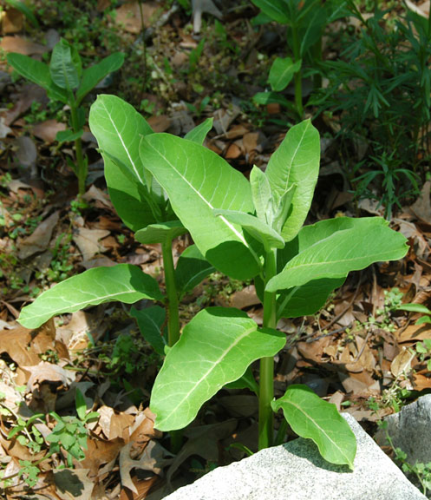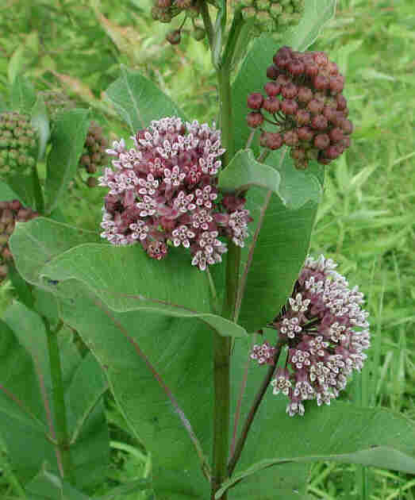Also Known As: milkweed, butterfly flower, silkweed, Virginia silk, cottonweed, wild cotton
Common Milkweed, Asclepias syriaca L., is native to North America and its range extends across most of the United States east of the Rocky Mountains. This tap-rooted plant reproduces mainly by seed, but once established it can regenerate vegetatively by rhizomatous roots bearing adventitious buds. An erect perennial herb, milkweed grows 2–6 feet tall. Although the stems of common milkweed are usually solitary, multiple stems can originate from a common root crown. Initially green, the stalks often turn deep red in the fall. The stems are hollow, subtly squared, seldom branched, and generally covered with short downy hairs. All plant parts contain a white milky latex that is excreted upon injury. The leaves  of common milkweed are opposite and broadly oval or oblong with smooth margins, prominent veins and an often red-tinged midrib. They measure 3–10 inches long and 2–5 inches wide. They have short leaf stalks (petioles) and velvety undersides. Milkweed flowers occur in rounded clusters at stem ends and in upper leaf axils. Individual flowers are small, 5-petalled with a 5-part central crown, sweetly scented, and each occurs at the end of a long, slender flower stalk. Although commonly lavender-pink, the flowers can also be shades of yellow or green.The flowers have both male and female parts, but must be cross-pollinated by insects to form seeds. A single common milkweed plant can produce an estimated 25 fruits with each fruit containing as many as 450 seeds. The conspicuous seed pods (follicles) are initially fleshy, pale green, covered with soft-pointed bumps, and shaped like long teardrops (3–5 inches long). With maturity, the follicles dry up and turn brown before splitting open lengthwise, releasing numerous brown flat seeds—each with a tuft of silky hair (pappus) attached to one end. Seeds, commonly carried off by the wind, reportedly remain viable in the soil for at least 3 years.
of common milkweed are opposite and broadly oval or oblong with smooth margins, prominent veins and an often red-tinged midrib. They measure 3–10 inches long and 2–5 inches wide. They have short leaf stalks (petioles) and velvety undersides. Milkweed flowers occur in rounded clusters at stem ends and in upper leaf axils. Individual flowers are small, 5-petalled with a 5-part central crown, sweetly scented, and each occurs at the end of a long, slender flower stalk. Although commonly lavender-pink, the flowers can also be shades of yellow or green.The flowers have both male and female parts, but must be cross-pollinated by insects to form seeds. A single common milkweed plant can produce an estimated 25 fruits with each fruit containing as many as 450 seeds. The conspicuous seed pods (follicles) are initially fleshy, pale green, covered with soft-pointed bumps, and shaped like long teardrops (3–5 inches long). With maturity, the follicles dry up and turn brown before splitting open lengthwise, releasing numerous brown flat seeds—each with a tuft of silky hair (pappus) attached to one end. Seeds, commonly carried off by the wind, reportedly remain viable in the soil for at least 3 years.
Common milkweed grows best in full sunlight or light shade and occurs in fields and waste areas and along roadsides, water body banks and forest margins. It is one of the most aggressive milkweeds and its purplish flowers that form ball-shaped clusters and its large warty seed pods—more striking than most milkweed pods—can help identify it. Hemp dogbane (Apocynum cannabinum) can also be confused for common milkweed, especially in early growth stages, but it has much smaller leaves and is so heavily branched that it forms a bushy plant.
All parts of common milkweed contain small quantities of potentially toxic substances. In particular, the plant contains moderate concentrations of cardenolides (cardiac glycosides) that are toxic to poultry and can poison grazing animals if consumed in sufficient quantities—this rarely occurs, however, because livestock generally avoid the plant if other forage is available. In humans, the plant is slightly toxic if eaten in large quantities and can cause dermatitis upon contact with the milky latex.
The bitter chemicals contained in the latex of common milkweed protect the plant from predators. A few insects are immune to these poisons and accumulate them in their bodies, affording them protection from their own predators. Among these immune insects is the Monarch butterfly. It cannot complete its life cycle without milkweed—its foliage is the sole source of food for the monarch butterfly larvae. The glycosides, when absorbed by the larvae, make the larvae and adult butterflies toxic to birds and other predators.
Control Methods
Preventive/Cultural Control: Although common milkweed is sometimes cultivated as an ornamental or allowed to grow to attract and provide food for monarch butterflies, it is important that the species not be allowed to escape. While seed production can be prevented by destroying seed pods before maturity, the plant’s extensive root system makes it nearly impossible to contain. Cultural control can include rotation into a competitive cover crop.
Mechanical Control: Cultivation does not work well because it spreads root fragments and cannot reach the roots of common milkweed that extend far below plow depth. To be effective, tillage must be done often enough to deplete underground root reserves—every two or three weeks. Warm, dry soil conditions increase the effectiveness of tillage for perennial weed control by drying plant roots on the soil surface.
Chemical Control: Chemical control of milkweed is difficult because the herbicide gets tied up in the latex of the plant and translocation of the herbicide through the plant is poor. Herbicides that have been the most effective for control are glyphosate, or picloram plus 2,4-D. These herbicides work the best when applied at the late-bud to flowering stage.
More information can be found in the PNW Weed Management Handbook
Use pesticides with care. Apply them only to plants, animals, or sites listed on the label. When mixing and applying pesticides, follow all label precautions to protect yourself and others around you. It is a violation of the law to disregard label directions. Store pesticides in their original containers and keep them out of the reach of children, pets, and livestock.
Biological: No biological control agents are known to exist.
Questions: contact Steve Van Vleet or phone (509) 397 – 6290
Photo credits included in pdf




